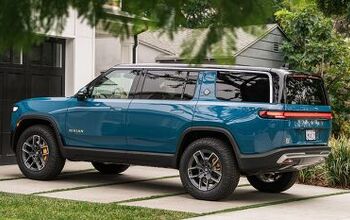Range Finder: Rivian Offers Smaller Battery on R1S and R1T

Hitting the powertrain of its pickup truck and SUV with a shrink ray has permitted Rivian to offer a new battery option – and a new price point – for its pair of all-electric models.
A so-called Standard battery is in the pipe, packing 106 kWh of capacity and an estimated 270 miles of driving range on a full charge. There will also be a Standard+ configuration, with 121 kWh and 315 miles range. In comparison to other options on the order sheet, the Large battery is rated at about 350 miles of total driving distance while the mighty Max battery carries a 410-mile estimate from the EPA eggheads.
You may expect these new arrangements to be accompanied by a lower price – and you’d be right. The fresh Standard arrangement is just over nine grand less expensive than the Large, meaning customers can get into an R1T for $71,700 or an R1S for $76,700. This sum unlocks the Dual Motor powertrain, good for 533 horsepower. Right now, that’s the only way to get the Standard battery, though the Standard+ can be paired with the tastier 665 hp Dual Motor Performance model.
For those keeping track, the Standard+ will be a $3,100 walk from the Standard; adding the Performance gubbins tacks on another five grand. Before destination fees, the R1T now slides under 70 large in Standard Dual Motor guise. And with numerous trims ducking under the $80,000 limbo bar, there could be some federal tax incentives in the offing. However, structure for EV rebates in America confuse this author to no end, so he will defer to our own Matt Posky, who is the resident expert on that topic.
These rigs are available to build and price on the Rivian website, suggesting they could be ordered and delivered before the snow melts.
[Images: Rivian]
Become a TTAC insider. Get the latest news, features, TTAC takes, and everything else that gets to the truth about cars first by subscribing to our newsletter.

Matthew buys, sells, fixes, & races cars. As a human index of auto & auction knowledge, he is fond of making money and offering loud opinions.
More by Matthew Guy
Latest Car Reviews
Read moreLatest Product Reviews
Read moreRecent Comments
- Lorenzo This car would have sold better if there was a kit to put fiberglass toast slices on the roof.
- Lorenzo The Malibu is close to what the 1955 Bel Air was, but 6 inches shorter in height, and 3 inches shorter in wheelbase, the former making it much more difficult to get into or out of. Grandma has to sit in front (groan) and she'll still have trouble getting in and out.The '55s had long options lists, but didn't include a 91 cubic inch four with a turbo, or a continuously variable transmission. Metal and decent fabric were replaced by cheap plastic too. The 1955 price was $1765 base, or $20,600 adjusted for inflation, but could be optioned up to $3,000 +/-, or $36,000, so in the same ballpark.The fuel economy, handling, and reliability are improved, but that's about it. Other than the fact that it means one fewer sedan available, there's no reason to be sorry it's being discontinued. Put the 1955 body on it and it'll sell like hotcakes, though.
- Calrson Fan We are already seeing multiple manufacturers steering away from EVs to Hybrids & PHEVs. Suspect the market will follow. Battery tech isn't anywhere close to where it needs to be for EV's to replace ICE's. Neither is the electrical grid or charging infrastructure. PHEV's still have the drawback that if you can't charge at home your not a potential customer. I've heard stories of people with Volts that never charge them but that's a unique kind of stupidity. If you can't or don't want to charge your PHEV then just get a hybrid.
- AZFelix The last time I missed the Malibu was when one swerved into my lane and I had to brake hard to avoid a collision. 1 out of 5⭐️. Do not recommend.
- 2ACL I won't miss it; it was decent at launch, but in addition to the bad packaging, GM did little to keep it relevant in the segment. I'd prefer that another domestic automaker doesn't just give up on the mainstream sedan, but unlike some of Ford's swan songs, the Malibu made an indifferent case for why they should live.


































Comments
Join the conversation
I've read that the body design and integration means exceptionally expensive repair costs for minor damage.
Still way too expensive for a PU or SUV with such limited capability and no resale value. Extra bonus is they are from a company that probably won't be around in 5 years due to their poor business model. I can think of so many better ways to foolishly spend $80K!